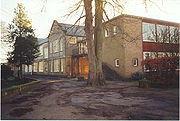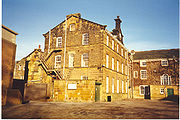
Great Ayton Friends' School
Encyclopedia


Great Ayton
Great Ayton is a village and civil parish in the Hambleton district of North Yorkshire on the edge of the North York Moors in England. The name Great Ayton is thought to derive from Ea-tun, tun meaning farm and 'ea' meaning river. It has a population of 4,570....
, North Yorkshire
North Yorkshire
North Yorkshire is a non-metropolitan or shire county located in the Yorkshire and the Humber region of England, and a ceremonial county primarily in that region but partly in North East England. Created in 1974 by the Local Government Act 1972 it covers an area of , making it the largest...
, England
England
England is a country that is part of the United Kingdom. It shares land borders with Scotland to the north and Wales to the west; the Irish Sea is to the north west, the Celtic Sea to the south west, with the North Sea to the east and the English Channel to the south separating it from continental...
, was an independent
Independent school
An independent school is a school that is independent in its finances and governance; it is not dependent upon national or local government for financing its operations, nor reliant on taxpayer contributions, and is instead funded by a combination of tuition charges, gifts, and in some cases the...
, co-educational, agricultural boarding school
Boarding school
A boarding school is a school where some or all pupils study and live during the school year with their fellow students and possibly teachers and/or administrators. The word 'boarding' is used in the sense of "bed and board," i.e., lodging and meals...
, run by the Religious Society of Friends
Religious Society of Friends
The Religious Society of Friends, or Friends Church, is a Christian movement which stresses the doctrine of the priesthood of all believers. Members are known as Friends, or popularly as Quakers. It is made of independent organisations, which have split from one another due to doctrinal differences...
(the Quakers).
The school was situated on High Green on an estate of around 70 acres (283,280.2 m²) in a picturesque setting in the shadow of the Cleveland Hills. The River Leven
River Leven, North Yorkshire
The River Leven is a river in North Yorkshire, England and is a tributary to the River Tees. It rises on Warren Moor, part of Kildale Moor, in the North Yorks Moors and flows to the north of the moors to join the River Tees at Yarm.-Course:...
(a tributary
Tributary
A tributary or affluent is a stream or river that flows into a main stem river or a lake. A tributary does not flow directly into a sea or ocean...
of the River Tees
River Tees
The River Tees is in Northern England. It rises on the eastern slope of Cross Fell in the North Pennines, and flows eastwards for 85 miles to reach the North Sea between Hartlepool and Redcar.-Geography:...
), ran through the school grounds and was bridged in several places.
History
Quakers in County DurhamCounty Durham
County Durham is a ceremonial county and unitary district in north east England. The county town is Durham. The largest settlement in the ceremonial county is the town of Darlington...
, having concern for children of disowned Friends who were not eligible for Quaker education, were searching for a suitable site to establish an agricultural school on their behalf. Unable to find a site in the preferred area of Bishop Auckland
Bishop Auckland
Bishop Auckland is a market town and civil parish in County Durham in north east England. It is located about northwest of Darlington and southwest of Durham at the confluence of the River Wear with its tributary the River Gaunless...
, Durham Friends sought the assistance of Thomas Richardson
Thomas Richardson
Thomas Richardson is the name of:*Thomas Richardson , Lord Chief Justice of England and Wales*Tom Richardson , cricketer*Thomas Richardson , cricketer...
, a Quaker from Darlington
Darlington
Darlington is a market town in the Borough of Darlington, part of the ceremonial county of County Durham, England. It lies on the small River Skerne, a tributary of the River Tees, not far from the main river. It is the main population centre in the borough, with a population of 97,838 as of 2001...
who had come to live in Great Ayton on his retirement in 1830.
In 1841 the school was established "for the maintenance of 36 boys and the same number of girls belonging to or connected with the Society of Friends; others are admitted at a charge representing about the average cost of each child per annum. There was now accommodation for 80 boarders. The course of instruction embraces Latin, French, Euclid, Geometry, Algebra, and various scientific subjects - Agriculture, Chemistry, Physiology, Botany, &c. The girls are trained either for domestic work or a higher sphere of life".
An estate of nearly 70 acres (283,280.2 m²) was purchased for the purposes of the school, and many additions were made to the premises.
Disownment for 'marrying out' ended in 1854, and the school changed with the times, becoming the Friends’ School.
The school gradually attracted greater numbers of pupils until there was no room large enough to contain all of the 300 pupils. In 1968 the Meeting House was enlarged to accommodate the complete student body.
In 1991 the school adopted a more commercial approach. It dropped its named association with the Quakers and adopted the new name 'Ayton School'. It appointed a marketing manager to promote the school’s facilities to the general public, a move that signalled hard times were around the corner.
The closure of the school in 1997 came as a shock and bereavement to the Quakers, the villagers of Great Ayton and the staff and pupils at the school. Dwindling pupil numbers had given the trustees no other option but to close the school at the end of the term. In a letter to parents, chairman Robert Campbell explained that 37 of the school’s 200 pupils had withdrawn from the school recently leaving the school massively short of funds.
The school’s 28 teachers and 22 other staff lost their jobs and the school’s grade II listed building and its 30 acres (121,405.8 m²) estate were put up for sale.
During its 157-year history the school was attended by almost 7,500 pupils and employed 550 staff.
Headmasters
George Dixon: 1841-1865,Ralph Dixon: 1866-1895,
F. Rivers Arundel: 1896-1913,
Herbert Dennis: 1913-1940,
J. Stanley Carr 1940-1952,
John Reader 1953-1975,
Fred Sessa 1976-1984,
David Cook 1985-1994,
Chris Scaife 1994.
Present
The Friends school estate was sold to Wimpey Homes. Working with English HeritageEnglish Heritage
English Heritage . is an executive non-departmental public body of the British Government sponsored by the Department for Culture, Media and Sport...
and The Georgian Society, the company established a development with attempted sympathy to the local style and to the surrounding architecture. Many of the school’s original features have been retained and the local wildlife and landscapes have been carefully managed.
Wimpey built 63 exclusive properties on the grounds. The styles vary from the farmhouse family homes, to cottages and traditional three-story town houses.
In the Richardson School Hall, 21 apartments were sold, ranging in price from £120,000 to £200,000.
The Quakers in Great Ayton set aside part of the meeting house as an 'Old Scholars' room containing many items selected by Old Scholars to be retained as mementoes of the School. The War Memorial plaque from the School dining room is placed there while the memorial benches remain in the meeting room.
Further reading
- G. Alston Watson; 'Ayton School Centenary History' 1841-1941.Headley Bros, 1941.
External links
- Ayton Old Scholars
- Ayton School, photographs of Great Ayton - West central building

